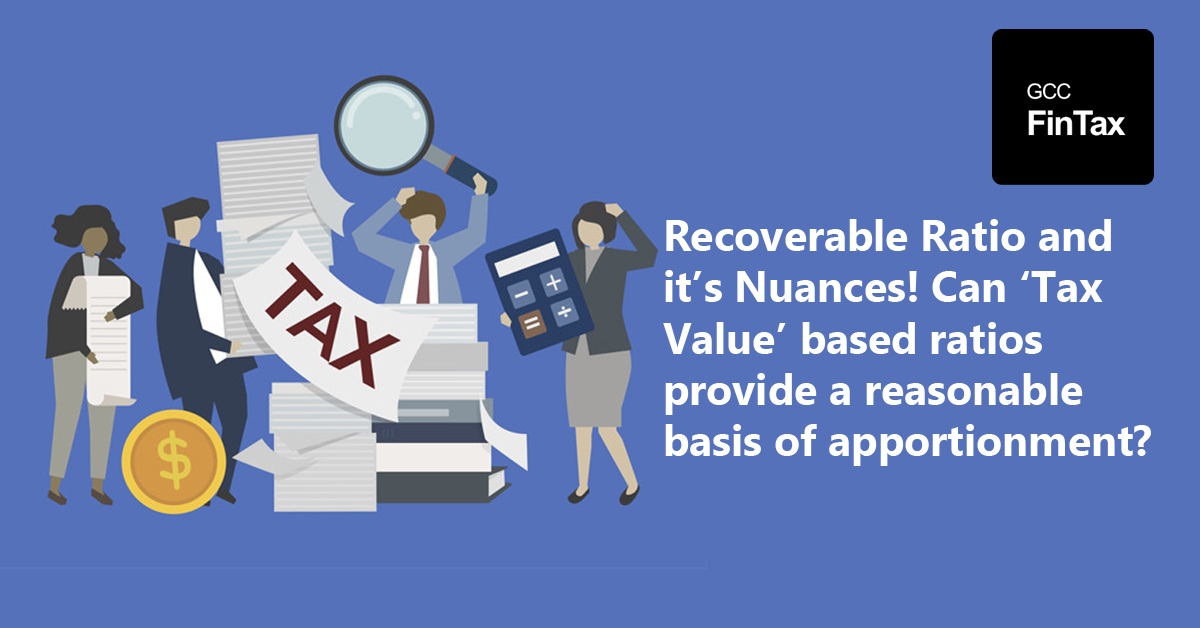
Recoverable Ratio and it’s Nuances! Can ‘Tax Value’ based ratios provide a reasonable basis of apportionment?
Input VAT Recoverable Ratio (also commonly known and understood as ‘Reversal ratio’, ‘Partial Deduction’ ‘Partial Exemption’ across the world) under an Indirect Tax Legislation is computed in order to apportion the value of input tax on expenses which are generally incurred by businesses to provide both taxable as well as exempt supplies which results in a fair and reasonable recovery of input tax. Typically, such expenses comprise of administration and other general overheads which businesses incur to function. As a matter of principle under Indirect Taxes, Input VAT directly attributable to taxable supplies are eligible for full recovery whereas that attributable to exempt supplies are not and is required to be expensed off by debiting to profit and loss account. Therefore, where an expense is commonly attributable to both taxable as well as exempt supplies, the apportionment method provided under VAT/GST legislation is to be applied to arrive at the value of input tax recovery on such common expenses.
Given the above background, The United Arab Emirates (UAE) has adopted a ‘Tax Value’ based formula as the standard method to compute the Recoverable Ratio. The formula for computing the said ratio is Recoverable Tax/ (Recoverable Tax + Non-Recoverable Tax), where ‘Recoverable Tax’ refers to Input VAT directly attributable to taxable supplies and ‘Non-Recoverable Tax’ refers to Input VAT directly attributable to exempt supplies. The ratio derived through this method is applied on the Value of Input VAT on expenses which are commonly attributable to both taxable and exempt supplies to arrive at the value of recoverable tax component on such common expenses. Given this, it could be argued whether the desired outcome to undertake this process is achieved by the application of this method (although the UAE VAT law provides where the difference between standard method and other specific method of apportionment is more that AED 250,000, a taxable person may be required to perform annual wash-up adjustments). Since, the ‘Tax Value’ based method is so much reliant on incurring of expense directly attributable to exempt supplies that in a scenario where a business does not incur any of such expenses, the recoverable ratio would be 100% in spite it undertaking exempt supplies which would not be the case in a ‘Turnover’ based method for input VAT apportionment.
Let us understand this by way of an Example: Where a company is extending interest bearing commercial loans/advances to other entities which is exempt under UAE VAT and does not incur any expenses directly attributable to such supplies on which it has paid VAT to any third party, in that case there is no non-recoverable tax incurred by the company and therefore the recoverable ratio is 100%. Accordingly, the company ends up recovering full value of input tax on common expenses even after making exempt supplies. Further, even in a scenario where a company incurs non-recoverable tax, the ultimate apportionment of input tax on common expenses may not be commensurate to the scales of operation of exempt viz-a-viz taxable supplies made by that company. The ratio may scale high or low depending on the proportion of recoverable tax compared to non-recoverable tax incurred by the company. This leaves us with the question ‘Can Tax Value based ratios provide a reasonable basis of input tax apportionment’?
Comparing this with other Indirect Tax jurisdiction, EU VAT Law (UAE VAT Law is a close resemblance of EU VAT Law) prescribes Turnover-based as the standard method for input tax apportionment. Similarly, other GCC Indirect Tax jurisdictions of Kingdom of Saudi Arabia and Bahrain follow the same Turnover-based method as a standard method of apportionment. The soon to be Indirect Tax Jurisdiction in GCC namely Sultanate of Oman would also be following the same method. Indian GST law also provides for usage of Turnover-based method as the standard method. Canada GST law provides usage of best possible apportionment method which is fair and reasonable as the standard method given the circumstance of the company – accordingly apportionment can be done using the most appropriate method of direct allocation, input-based allocation (input turnover based and not tax value based unlike the standard method used in UAE for apportionment) and output-based allocation. Accordingly, as can be seen, the most commonly used apportionment method seems to be on the basis of turnover – either revenue/expense, which according to such jurisdiction presents a fair and reasonable outcome. Given this, whether the same results could also be achieved by a ‘Tax Value’ based apportionment method? Further thoughts are welcome.
Disclaimer: Content posted is for informational & knowledge sharing purposes only, and is not intended to be a substitute for professional advice related to tax, finance or accounting. The view/interpretation of the publisher is based on the available Law, guidelines and information. Each reader should take due professional care before you act after reading the contents of that article/post. No warranty whatsoever is made that any of the articles are accurate and is not intended to provide, and should not be relied on for tax or accounting advice.
You can access Law including Guidelines, Cabinet & FTA Decisions, Public Clarifications, Forms, Business Bulletins for all taxes (Vat, Excise, Customs, Corporate Tax, Transfer Pricing) for all GCC Countries in the Law Section of GCC FinTax